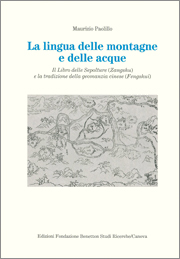
La lingua delle montagne e delle acque
Il Libro delle Sepolture (Zangshu) e la tradizione della geomanzia cinese (Fengshui)
edited by Maurizio Paolillo
Fondazione Benetton Studi Ricerche-Canova
Treviso 2013
184 pagine
4 illustrations in colour and 23 black and white
cover price 25 euros
ISBN 978-88-8409-266-3
(Memorie/monografie, 15)
[The language of the mountains and the waters. The Book of Burial (Zangshu) and the tradition of Chinese geomancy (Fengshui)]
The Book of Burial (Zangshu), a work which is traditionally attributed to the III-IV century Chinese scholar Guo Pu, but which probably dates from the IX-X century as we now know it, here receives its first translation from classical Chinese into Italian. The text is an essential point of reference for contemporary fengshui schools.
In recent years Chinese fengshui (geomancy) has been at the centre of a cultural frenzy that has often resulted in its original features being distorted in adapting it to utilization in the West. Fengshui can be defined as a theoretical and practical system that originated and developed over the centuries in China; it is based on the ancient correlative cosmology, and in particular on qi, the natural energy that flows through landscape. The aim of fengshui is to identify sites suitable for the buildings of the living, or also of the dead, in the context of a natural or anthropized landscape.
The Book of Burial is rich in doctrinal principles and uses a complex technical vocabulary to describe and appraise landscapes in terms of the qi life force flowing through them (shengqi), by analyzing the shapes of the terrain on a large and small scale. This specific concern for landscape, especially for the “vein lines” of qi, is also expressed through the production of maps, which together form a separate branch of the rich tradition of Chinese cartography.
The translation is accompanied by a comprehensive explanatory apparatus, which includes a glossary of specific Chinese terms and an introductory study dedicated to the appraisal and meaning of landscape infengshui, and to the essential features of landscape as expressed in the Book of Burial. The volume finishes with an extensive bibliography listing classical sources and both western and Chinese studies, an indispensable tool for anyone wishing to explore a tradition that constitutes a fundamental part of the Chinesetheoria of landscape.
Contents
Prefazione, 7
I. Lettura e significato del paesaggio nella tradizione cinese, 9
1. La geomanzia cinese vista da Occidente, 9
2. I fondamenti cosmologici del fengshui: i simboli del pensiero analogico, 13
3. Il paesaggio-drago, 25
4. Le Venature della Terra e la corrispondenza con i Segni del Cielo, 30
5. Cielo, Terra e Uomo: il paesaggio umano, 35
6. La nascita e lo sviluppo del fengshui, 44
7. Il paesaggio geomantico e i suoi elementi strutturali: breve quadro d’insieme, 58
II. I fondamenti del paesaggio secondo lo Zangshu, 73
1. Il testo e il suo presunto autore, 73
2. Il modello della risonanza come base della lettura del paesaggio, 77
3. Gli elementi del paesaggio significativo, 84
4. Lo spazio qualitativo del fengshui e l’arte del “conformarsi”: un tentativo di conclusione, 90
Tabelle, 99
Zangshu/Libro delle Sepolture, 103
Nota all’edizione, 105
Appendice, 108
Sezione Interna, 109
Sezione Esterna, 129
Sezione Miscellanea, 141
Glossario, 151
Bibliografia, 161
Indice dei nomi e dei luoghi, 177
Maurizio Paolillo (Naples, 1966) is a Research Fellow and Associate Professor of Chinese Language and Culture at the University of Salento. He graduated in 1990 with the first Chinese studies dissertation in Italy on fengshui, a subject to which he has since devoted two decades of study of the classical sources. His numerous publications include a monograph on the tradition of the garden in China (Il giardino cinese. Una tradizione millenaria, Guerini e Associati, Milan 1996, which received a special mention for the 1997 Hanbury Grinzane Cavour Prize) and a study of the history of fengshui (Il fengshui. Origini, storia e attualità, Carocci, Rome 2012).
